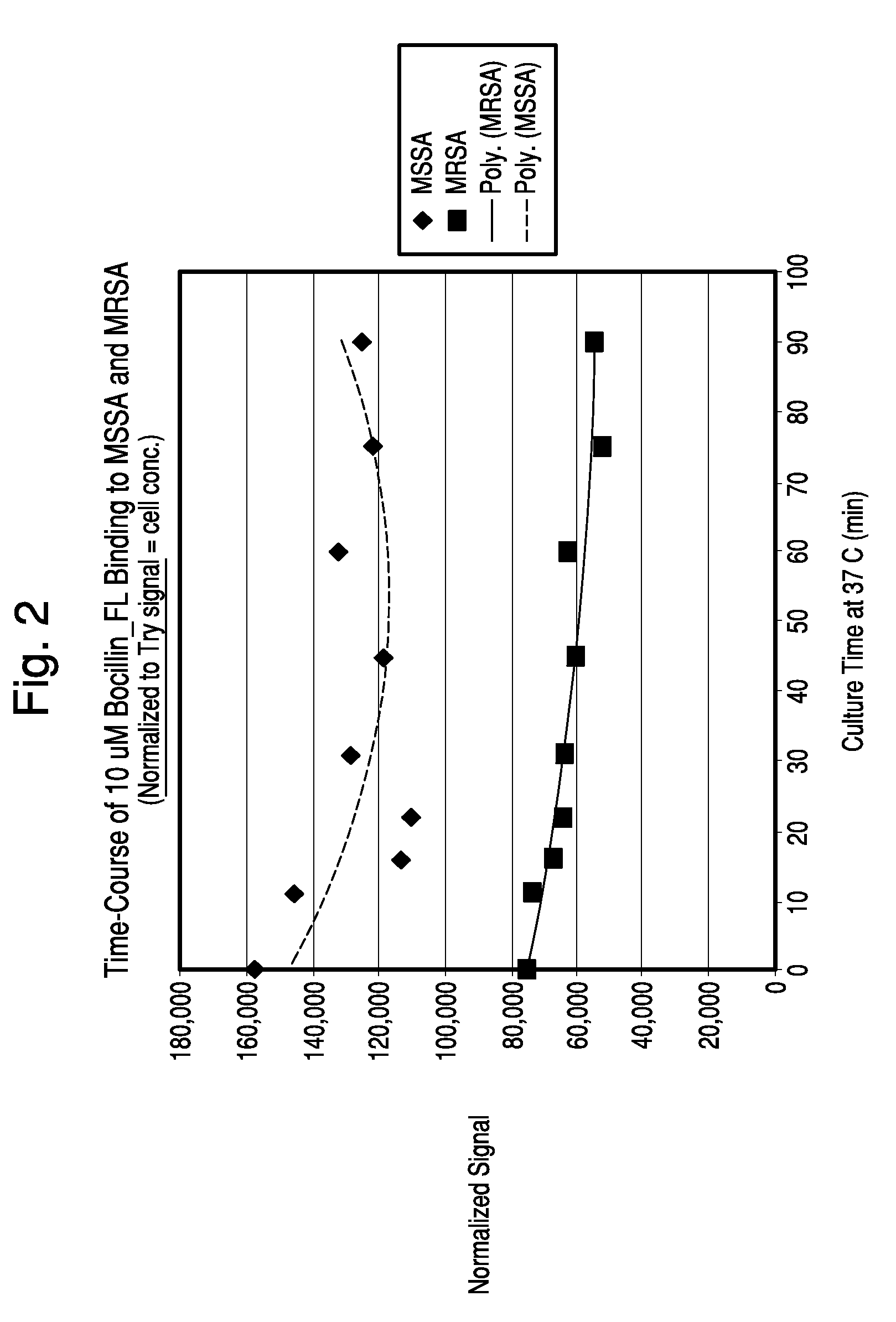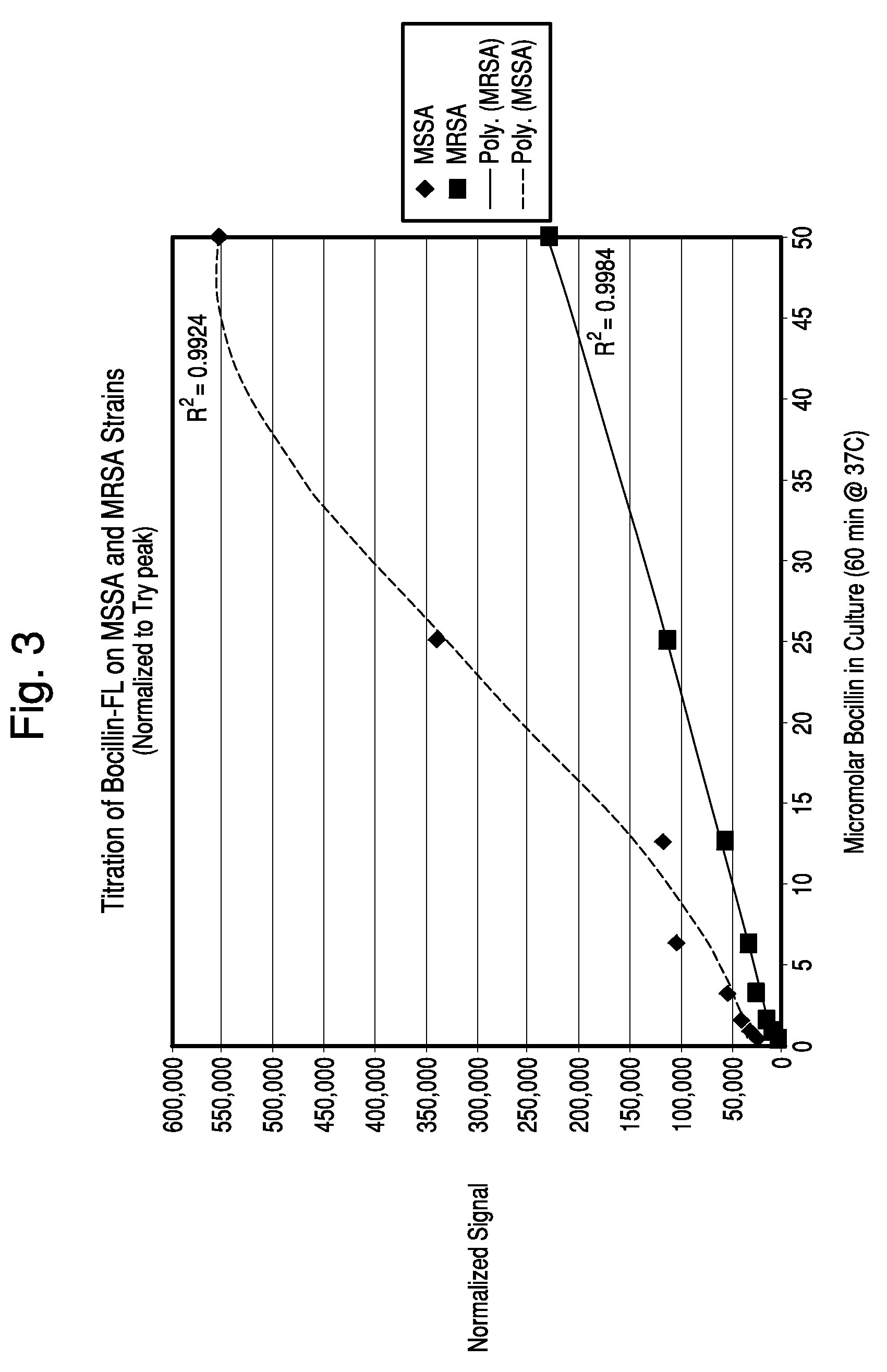Methods for Antimicrobial Resistance Determination
- Summary
- Abstract
- Description
- Claims
- Application Information
AI Technical Summary
Benefits of technology
Problems solved by technology
Method used
Image
Examples
example 1
Binding of BOCILLIN™-FL to MRSA and MSSA Strains
[0081]Two experimental approaches were used to test BOCILLINT™-FL (Molecular Probes, Invitrogen) binding to S. aureus: (1) treating cells with sodium hydroxide (NaOH), neutralizing, adding BOCILLIN™-FL, then separating the cells (harsh pretreatment); and (2) culturing cells with BOCILLINT™-FL, then separating the cells (metabolic labeling).
[0082]For the first method, S. aureus strains ATCC 25923 (Methicillin-Sensitive; MSSA) and D14906 (Methicillin-Resistant; MRSA) were cultured until exponential growth (6 hours) in tryptic soy broth (TSB). Samples of each suspension (0.9 ml in TSB) and 0.1 N NaOH (0.1 ml; ±20 μl 7.5% TRITON® X100-R) were vortexed for 5 seconds, then either neutralized immediately or after 1 minute by adding 1 M KH2PO4 (0.125 ml) and vortexing for 5 seconds. BOCILLINT™-FL (15 μl of 1.0 mg / ml) was added to the suspension, which was then vortexed, and incubated for 5 minutes at room temperature. Unbound BOCILLINT™-FL was...
example 2
Time Course Experiment
[0086]Samples of S. aureus strains ATCC 25923 (MSSA) and D14906 (MRSA) were grown in BacT / ALERT SA culture media at 37° C. until exponential growth was reached (8-10 hours). The OD 660 nm of each culture was measured and both suspensions were adjusted to 0.50 with pre-warmed SA media. BOCILLINT™-FL was diluted in pre-warmed SA media, filtered through a 0.2 μm filter and kept at 37° C. Samples of the bacteria (9.0 ml) were mixed with 1.0 ml of 100 μM BOCILLINT™-FL, mixed well, and dispensed as ten 1.0 ml aliquots into microfuge tubes containing 0.2 ml of the same oil blend used in Example 1. All tubes except the To tube were placed at 37° C. Tubes were removed and processed at 6, 11, 16, 22, 45, 60, 75, and 91 minutes. Each tube was centrifuged for 1 minute, the supernatant was aspirated, and the pellet was resuspended in 0.1 ml PBS and then added to 3.0 ml PBS in an acrylic cuvette. The sample was scanned in the FluoroLog-3 system at an excitation wavelength of...
example 3
Titration of BOCILLIN™-FL
[0088]Samples of S. aureus strains ATCC 25923 (MSSA) and D14906 (MRSA) were grown in BacT / ALERT SA culture media at 37° C. for about 6 hours until an OD 660 nm of about 0.35 was reached. Dilutions of BOCILLINT™-FL (0.1 ml) were prepared in SA medium and placed into culture tubes. Samples of the bacterial suspension (0.9 ml) were added to the tubes and mixed. The tubes were capped and placed in a 37° C. incubator for 60 minutes. Samples (1.0 ml) were transferred to microfuge tubes containing 0.2 ml of the same oil blend used in Example 1, centrifuged for 1 minute, aspirated, and the pellet was resuspended in 0.1 ml PBS and then added to 3.0 ml PBS, pH 7.4 in an acrylic cuvette. The sample was scanned in the FluoroLog-3 system at an excitation wavelength of 490 nm and the fluorescence emission at 510 nm was recorded.
[0089]The MSSA strain bound 2-4 fold more BOCILLINT™-FL than the MRSA strain on a per cell basis, depending on the BOCILLINT™-FL concentration (FI...
PUM
| Property | Measurement | Unit |
|---|---|---|
| Density | aaaaa | aaaaa |
| Density | aaaaa | aaaaa |
| Density | aaaaa | aaaaa |
Abstract
Description
Claims
Application Information
 Login to View More
Login to View More - R&D
- Intellectual Property
- Life Sciences
- Materials
- Tech Scout
- Unparalleled Data Quality
- Higher Quality Content
- 60% Fewer Hallucinations
Browse by: Latest US Patents, China's latest patents, Technical Efficacy Thesaurus, Application Domain, Technology Topic, Popular Technical Reports.
© 2025 PatSnap. All rights reserved.Legal|Privacy policy|Modern Slavery Act Transparency Statement|Sitemap|About US| Contact US: help@patsnap.com



